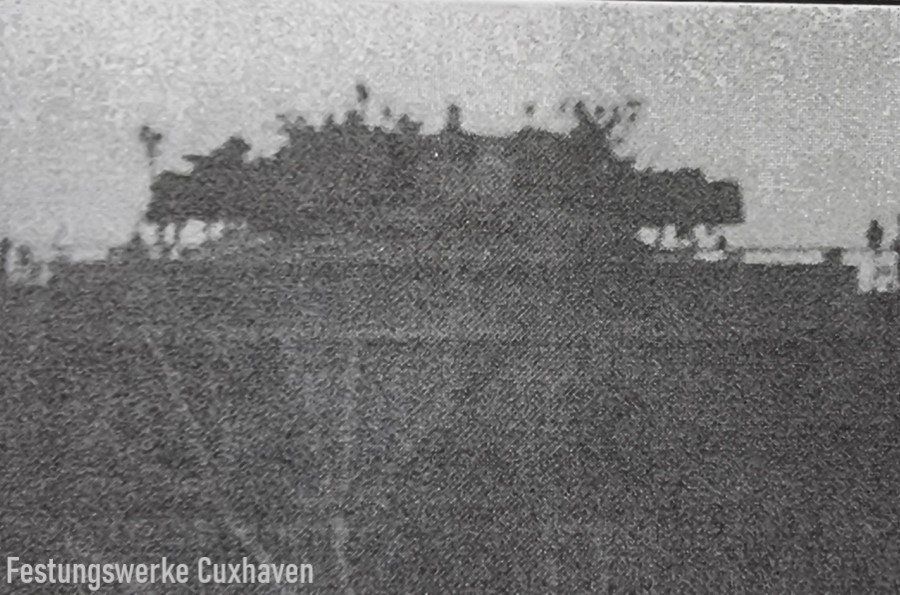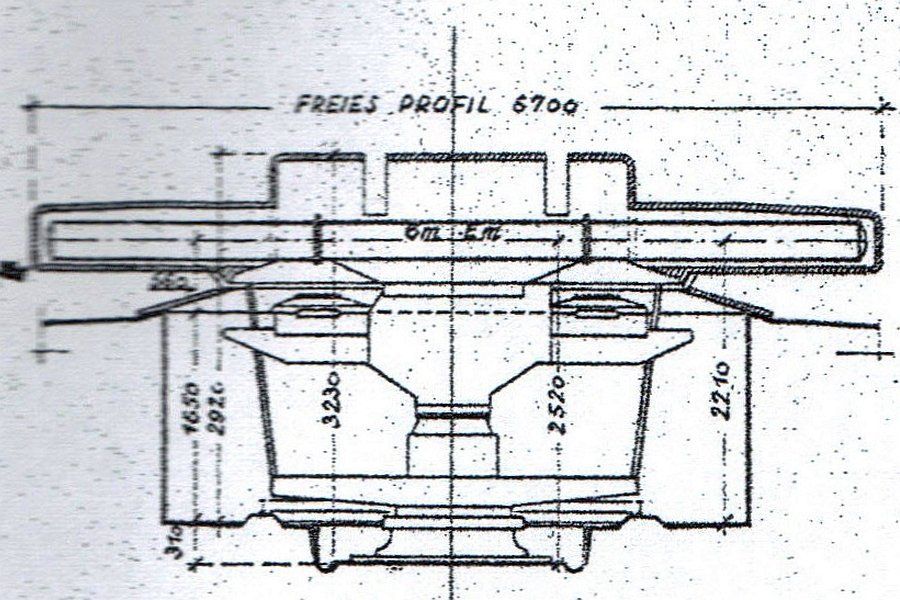Technology in the battery
The Flak Windscreen
The anti-aircraft windscreen is used to determine the wind T.-V., the wind lead and the spin depending on distance, aiming direction to the wind direction, wind strength and ballistics. It consists of the following parts: housing, table, cam disc, firing direction indicator, degree ring, glass cover and night lighting system.
The cam disc is placed on the table so that the recess in the latter engages with the pin on the table. There are yellow concentric circles on the cam disc which are used to determine the spin. They become narrower towards the outside as the spin deviation increases with increasing distance. There are also red and green solid lines for determining the wind T.-V. The target height and wind speed can be read in the middle part of the cam disc. The wind direction arrow is also attached here. There are anti-aircraft wind discs from 4 to 34 m/sec., divided from 2 to 2 m/sec. The ballistics are indicated on the edge of the disc. The degree ring is divided into 360 degrees. It is mounted so that it can rotate. The firing direction arrow circles above the cam disc. It is provided with a hm division from 10 to 75 hm.
Nachdem die Nr.9 die Messentfernung ausgerufen hat, greift der Bedienungsmann der Flakwindscheibe dieselbe am Schussrichtungszeiger ab und beobachtet, wo dieser mit einer der Kurven schneidet. Die Werte für Windvorhalt und Drall stellt er an der dreifachen Verbesserung ein. Die Wind-T.-V. ruft er Nr.4 zum Einstellen an der T.-V.-Skala zu. Dabei werden diese Werte genauso verrechnet wie die Kommandoverbesserungen des Flak- Leiters.

Scheinwerferausbildung

Exerzieren am 60 cm Flakscheinwerfer. Rechts Oberfeldwebel Schünemann, Marinehelfer Steffens und Kröncke. Im Hintergrund Leitstand 2 (Fumg 41g).

Sad everyday life for the young naval helpers. What seemed like a game was the bitter reality of a brutal war on both sides. (MB)
Dreiwag Coast heavy (three-roller device)
The Dreiwag (three-roller device/naval designation for the command device 36/38) is a measuring and command device for heavy anti-aircraft batteries on land. It is also equipped with a 6 m optic. It calculates the lead angle mechanically by evaluating the angle of impact and the angle of impact elevation. The recorded values are also used to determine the setting time for the time fuses of the grenades (flight time of the projectiles to the target point). The values determined by the Dreiwag are sent to the receiving systems of the guns via the three sensors. The distribution box makes it possible to connect several guns. The device itself must be located in the center of the battery. It is transportable, but this requires major preparation. It can also be used for any anti-aircraft battery and only needs to be set to the respective caliber. To protect the crew, the device is equipped with an armored cupola and can be rotated 360 degrees.

The "Dreiwag Küste schwer" with the 6 m base on the control station 1 of the Flak battery Kugelbake.

Description of the work processes on the Dreiwag
The WLV is not tied to any one location. It monitors the activities of the operating personnel and repeats all commands from the anti-aircraft commander that are relevant to the device. After the message "EM target detected", it orders the elevator and rudder rollers to "engage".
He summarizes the clear message from the three cylinders as "device is engaged". He immediately reports any malfunctions to the anti-aircraft commander, and immediately eliminates minor malfunctions during firing. When changing targets, he orders "disengage" and after acquiring "engage".
No. 1 is the E-meter. With No. 2 and No. 3 he picks up the target and reports "E.-M.. Target picked up". When the measuring mark is brought over the target, he reports "Set". He calls out all target movements: "Coming (walking, standing) target". He must turn the measuring wheel according to the trend.
No. 2 is the lateral alignment number. Before the device swings, he must ensure that the lateral roller is disengaged. He takes aim over the coarse sight until the E. meter has picked up the target. Then he looks through the eyepiece and keeps the target in the crosshairs by turning it evenly. When he hears "Stop, battery, stop!" he swings the device to zero degrees and ensures that the lateral roller is disengaged. He must pay attention to the blockage.
No. 3 is the altitude reference number. It records the target in terms of height. It is operated in a similar way to No. 2.
No. 4 operates the left TV side of the distance measurement. She sets the clockwork and adjusts it. On the target height setting she sets the target height that she receives from No. 10 and adjusts the corresponding curve bundle. During the run-up she sets the wind and ground TV, which are algebraically calculated, on the upper scale. On the lower scale she sets the improvements of the anti-aircraft conductor in "forward" and "backward", which are also calculated.
No.5 operates the Ewa. After the E-knife message "Set" it lifts the locking of the tangent handwheel, places the tangent on the last part of the curve and reports "Ewa set". When "Stop, battery, stop!" is heard, the tangent is placed vertically and the tangent handwheel is locked.
No. 7 operates the side roller. It sets the clockwork and regulates it. When it says "engage" it engages the side roller and places the tangent on the last part of the written curve. The left hand always remains on the coupling lever. It first reports "side roller set". When the carriage reaches the end position, it disengages and turns it to a more favorable position. When it says "stop, battery, stop!" it disengages. As soon as the device is in the zero position, it sets the tangent vertically. No. 8 operates the elevation roller in the same way as No. 7 operates the side roller. It must also adjust the altitude of the anti-aircraft ladder, e.g. "10 higher!" or "5 lower!", "stands!".
No. 9 operates the TV drum. It keeps the measuring distance shown in the counter in line with the TV drum and the target elevation angle indicator. As soon as the E-meter has reported "set", it calls out the distance, later only from 5 to 5 km.
No. 10 operates the attachment drum. At the start of the run-up, it immediately determines the target height based on the announced measuring distance. In addition, it continuously adjusts the detonator setting time, which appears in the counter, to the point of impact at the relevant curve on the attachment drum.
No. 11 is the main BÜ and operates the triple improvement. She passes all the commands from the commander to the guns by telephone. As soon as she has received the spin and windage from No. 13, she sets these values. She must first convert the windage into the horizontal on the converter drum.
No. 12 is the salvo timer. It establishes the connection to the guns by ringing a bell following the commander's orders.
No. 13 operates the anti-aircraft windscreen. It determines the wind speed, the spin and the wind angle based on the distance announced. The wind speed calls out the wind angle and the spin of No. 11 to No. 4. Source: Harald Schönemann, Marinehelfer der Batterie Kugelbake 1943-1945


